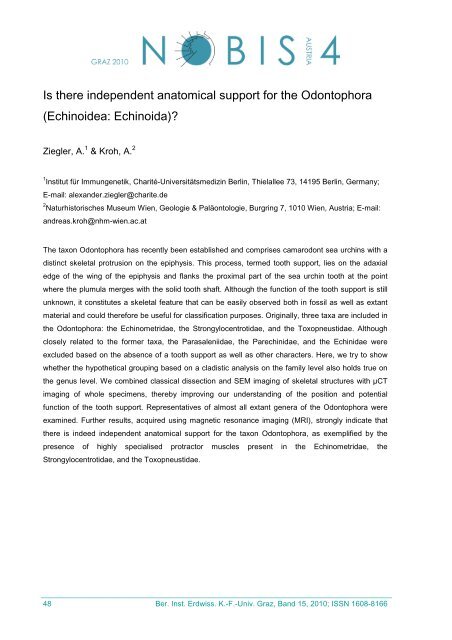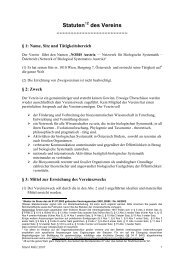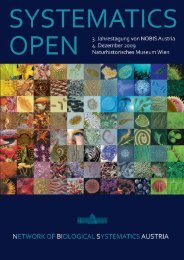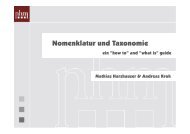4. Jahrestagung von NOBIS Austria 2. - 3. Dezember 2010
4. Jahrestagung von NOBIS Austria 2. - 3. Dezember 2010
4. Jahrestagung von NOBIS Austria 2. - 3. Dezember 2010
You also want an ePaper? Increase the reach of your titles
YUMPU automatically turns print PDFs into web optimized ePapers that Google loves.
Is there independent anatomical support for the Odontophora<br />
(Echinoidea: Echinoida)?<br />
Ziegler, A. 1 & Kroh, A. 2<br />
1 Institut für Immungenetik, Charité-Universitätsmedizin Berlin, Thielallee 73, 14195 Berlin, Germany;<br />
E-mail: alexander.ziegler@charite.de<br />
2 Naturhistorisches Museum Wien, Geologie & Paläontologie, Burgring 7, 1010 Wien, <strong>Austria</strong>; E-mail:<br />
andreas.kroh@nhm-wien.ac.at<br />
The taxon Odontophora has recently been established and comprises camarodont sea urchins with a<br />
distinct skeletal protrusion on the epiphysis. This process, termed tooth support, lies on the adaxial<br />
edge of the wing of the epiphysis and flanks the proximal part of the sea urchin tooth at the point<br />
where the plumula merges with the solid tooth shaft. Although the function of the tooth support is still<br />
unknown, it constitutes a skeletal feature that can be easily observed both in fossil as well as extant<br />
material and could therefore be useful for classification purposes. Originally, three taxa are included in<br />
the Odontophora: the Echinometridae, the Strongylocentrotidae, and the Toxopneustidae. Although<br />
closely related to the former taxa, the Parasaleniidae, the Parechinidae, and the Echinidae were<br />
excluded based on the absence of a tooth support as well as other characters. Here, we try to show<br />
whether the hypothetical grouping based on a cladistic analysis on the family level also holds true on<br />
the genus level. We combined classical dissection and SEM imaging of skeletal structures with µCT<br />
imaging of whole specimens, thereby improving our understanding of the position and potential<br />
function of the tooth support. Representatives of almost all extant genera of the Odontophora were<br />
examined. Further results, acquired using magnetic resonance imaging (MRI), strongly indicate that<br />
there is indeed independent anatomical support for the taxon Odontophora, as exemplified by the<br />
presence of highly specialised protractor muscles present in the Echinometridae, the<br />
Strongylocentrotidae, and the Toxopneustidae.<br />
_____________________________________________________________________________<br />
48 Ber. Inst. Erdwiss. K.-F.-Univ. Graz, Band 15, <strong>2010</strong>; ISSN 1608-8166






